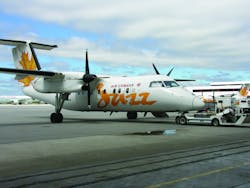Jazz Plays a GSE Technique
Jazz Aviation LP (“Jazz”) rose from the merger of four regional carriers in Canada in 2002. Its diverse business model includes three primary pillars: acting as a regional carrier for Air Canada, providing independent charters and services, and most recently taking on new business for Thomas Cook Canada Inc. With much action happening in its flight portfolio, Jazz’s GSE component has not been overlooked. In fact, the carrier is making aggressive strides in an effort to renew its GSE equipment fleet.
Business Model
The regional carrier’s operations consist of about 800 flights a day to more than 80 destinations in North America. Its main customer is Air Canada, and Jazz operates these flights under a capacity purchase agreement. (Just this year, Air Canada announced the rebranding of all its regional operations to “Air Canada Express” resulting in the elimination of the “Air Canada Jazz” brand name.) Also, Jazz continues to pursue new opportunities to expand its business.
In 2010 it signed a five-year agreement with Thomas Cook Canada Inc. to operate B757-200s from the November-through-April season from Canadian gateways to various sun destinations. These flights operate under the brand name Thomas Cook Canada. Also in 2010, the company made a significant investment in Pluna, a regional airline based in Uruguay.
The melding of multiple carriers in its origination has also led to a diverse ground handling model. The company owns about 2300 pieces of GSE in total, according to Paul Wells, system support and GSE manager at Jazz. At line stations, such as Bathurst, New Brunswick and Sydney, Nova Scotia, the company owns it own GSE, however, contracts services out to suppliers at the airports. “We’re trying to strike a balance in these situations where it makes sense to own equipment,” Wells explains.
At its main hubs, which include Toronto, Calgary, and Vancouver, the carrier does not perform ground handling. That’s conducted by Air Canada, which also owns all the ramp equipment at those locations. However, the company does perform maintenance services for aircraft at those stations, as well as in Halifax and London, Ontario. Accordingly, GSE equipment and some tooling such as aircraft jacks and work stands, falls under the GSE category and responsibility.
The company does perform some of its own ground handling services at stations such as Victoria, London (Ontario), and Val-d’Or, where ground operations were in play before the merger and retained.
Inventory & Maintenance Tracking
With a mix of equipment and operations throughout its network, a better way of tracking equipment was needed, according to Wells. The company headed an ambitious initiative to collect accurate data on each piece of equipment, including type and model, and input it into a new system called TRAX. It’s a system that Jazz has used to track aircraft maintenance, and recently the company chose to begin utilizing a GSE module.
“The program helps provide good visibility on our equipment and maintenance.” Wells says. “One of the biggest challenges with equipment across the continent is to understand what you own and to ensure you have the make, models, and serial numbers of everything in a system to assist in scheduling, performing and tracking maintenance.”
The process included validating existing data and aggressively collecting new information, which took about a year, according to Wells. He points out that maintaining the inventory will be an ongoing effort. However, he has seen the benefits first hand, as the system allows a user to track PMI schedules on each type of unit, as well as oversee and generate work orders instantly. Also, the system allows the company to accurately track the total cost of ownership of each unit, and set PMI targets (currently set at 90 days for most equipment types).
“Another important aspect is to develop a realistic maintenance program that ensures safety, meets code, satisfies your reliability needs and is able to be executed,” Wells notes.
Telemetry Initiative
The company is looking to take tracking of equipment one step further. Wells says they are working on a business plan to implement GPS tracking on some of the equipment to gather useful data on usage patterns as well as reduce fuel and maintenance costs. “This also aligns with our goal to reduce our carbon footprint and get a feel for how much equipment you truly need,” he explains.
Jazz is demoing a tracking unit on a service vehicle in the system. Initial results have found that idling constituted 77 percent of the total engine run time. “If you can reduce that even by 25 percent, just think of the fuel and maintenance reduction,” he says.
When it comes to the cost of the system, he says the anticipated return is well worth the investment. “I think even with the costs, the projected savings on ground damage, productivity, fuel and maintenance will outweigh that,” he says, adding that Jazz is hoping to begin to utilize the system in some stations by the end of the year.
Fleet Renewal Strategy
The new inventory system and GPS tracking initiative will serve as major components to the company’s overall fleet renewal strategy, according to Wells. The general scheme currently in motion for replacing equipment is every 10 years for a service vehicle, and every 15 years for a GSE unit. “We’re replacing 20 or so pieces of equipment a year,” he says.
However, Wells notes that the new initiatives in play will help to more accurately record a unit’s viability within a fleet. “We realize that age alone doesn’t dictate replacement,” he says, adding that the new programs will also help to decide the need for additional equipment at locations.
Both the maintenance and GPS tracking initiatives will help Jazz keep a handle on its equipment. As the company continues to diversify by pursuing new lines of business, such programs will no doubt be paramount in ensuring the right equipment is in place when needed to keep the planes ready to fly.
